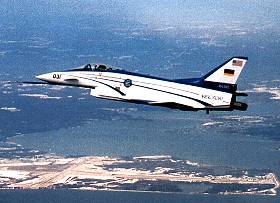





VECTOR team completes first flight period for X-31
April 29, 2001

he X-31 thrust-vectored technology demonstrator successfully completed its first flight period for the VECTOR test program April 6 at Naval Air Station Patuxent River, with German Naval Reserve Cmdr. Ruediger "Rudy" Knoepfel at the controls. VECTOR is a joint venture between the Navy, Germany's federal defence procurement agency (BWB), European Aeronautic Defence and Space (EADS) Corporation and Boeing Aerospace.
First flown in the early 1990s for the Enhanced Fighter Maneuverability (EFM) program, the X-31 is now being used to explore applications of thrust vectoring (TV) for extremely short takeoff and landing (ESTOL), particularly with an eye toward the carrier landing environment.
Since its first flight at Pax River on Feb. 24, it has logged 10 functional check flights under the command of Knoepfel and Naval Strike Aircraft Test Squadron's Cmdr. Vivan "Noodles" Ragusa. Between them, the two pilots have flown the aircraft to 24,000 feet and .8 Mach. The jet now enters a six-month reconfiguration period in preparation for its next flight test period.
Friday was also the first time that the X-31 has been flown using its vectored thrust capabilities since its appearance at the Paris Air Show in 1995. The X-31 is equipped with three paddle-like tail vanes that, when activated, redirect the engine's exhaust plume in response to pilot input. This "thrust vectoring" can be used to provide control and lift at speeds and angles that would otherwise induce a stall, up to 70 degrees angle of attack (AoA). Although the first nine flights at Pax had only utilized the aircraft's conventional flight control surfaces, on Friday Knoepfel engaged the TV system and commanded the aircraft to a 30-degree AoA, just below what is considered post-stall maneuvering.
"It was a very stable, smooth flight," Knoepfel said. After taking the aircraft to 5,000 feet, he performed a series of pitch, yaw and roll maneuvers, with the TV vanes providing directional control in all three axes.

"We were able to verify the functionality of the flight control laws with the TV system enabled," added Harvey Henn, the Navy's lead flight test engineer for VECTOR.
According to Flight Test Director Paul Conigliaro, the nine-flight buildup to TV flight included a thorough checkout of all of the aircraft's systems, as well as calibration of the flight control system to the unique characteristics of the engine's exhaust plume. The General Electric F404 engine that powers the X-31 was assembled from hand-picked parts for maximum reliability, Conigliaro said.
Though pleased with the TV flight, the test team is just as proud of a number of subtler achievements. "A big goal of this period was for the air crew and the test team to gain experience and confidence with operating this plane here at Pax River," Conigliaro said. "We've come to maturity together as a team."
The program's relationship with the air station community has also evolved, as Pax River has learned how best to serve the needs of the one-of-a-kind X-plane. "From Air Operations to the Fire Department," Conigliaro said, "everyone on the base has been really supportive."
"Another remarkable fact is that we brought this airplane up after five years of sitting in storage, and yet we have never had to return to base because of an aircraft failure of any kind," Henn said. The X-31 was mothballed after EFM in 1995, and required major overhauling when it arrived at Pax River in April of last year.
Over the next six months, the test team will reconfigure the aircraft for flying "ESTOL up and away," in which Ragusa and Knoepfel will fly vectored thrust, high-angle approaches to a virtual runway in the sky. The aircraft will also be fitted with EADS' new Flush Air Data System (FADS), a nose-mounted sensor package that provides speed, altitude, temperature and flight attitude data at all angles of attack.
The ESTOL up and away test phase will run from November of this year until April 2002, after which the aircraft will again be reconfigured for its final flight period under VECTOR, in which it will fly its dramatic high-angle, reduced speed approach to touchdown on the runway. "By increasing the approach angle of attack, from the normal 12 degrees up to a maximum of 40 degrees, we'll be reducing (approach speed) by over 30 percent," Conigliaro said. "The art of this is that you want to put the engine nozzle about two feet above the runway, and then de-rotate the plane and touch down the wheels."
A video camera in the belly of the plane will provide feedback to the pilot via a cockpit display. However, during final approach, the plane will be controlled by the autopilot, using combined inertial navigation system and global positioning system data to control the aircraft's location to within centimeters.
In the carrier landing environment to which the ESTOL technology might someday transition, a small reduction in landing speed could make a difference of 1,000 pounds in bring-back weight, allowing pilots to land with fuel and weapons that would otherwise need to be jettisoned, Conigliaro said. Reduced landing speeds also translate into less wear and tear for the aircraft and arresting gear, as well as reduced wind-over-deck requirement for the ship.
There is an awareness among the test team that they are in uncharted waters, exploring concepts that have never been tested before, but with that comes a certain pride. "This is a real X-plane," Knoepfel said with a grin. "It's the only manned X-aircraft that is purely a research aircraft."
Text source: James Darcy, dcmilitary.com, April 19, 2001
© 2001 CheckPoint |














